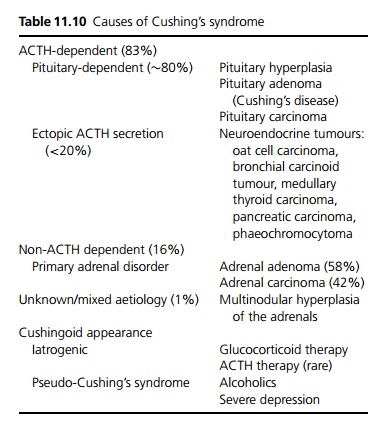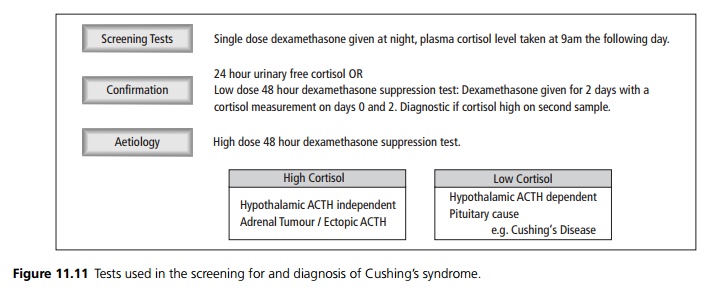Chapter: Medicine and surgery: Endocrine system
CushingŌĆÖs syndrome - Adrenal axis
CushingŌĆÖs syndrome
Definition
CushingŌĆÖs syndrome is the clinical syndrome resulting from excess circulating glucocorticoids.
Aetiology
The excess of glucocorticoid may be endogenous or exogenous. Endogenous glucocorticoids may result from high ACTH causing excessive adrenal stimulation or may result from a primary adrenal disease in which case ACTH levels will be low (see Table 11.10).

Pathophysiology
Cortisol opposes insulin, with a catabolic effect. Adrenal mineralocorticoid secretion is mildly raised, but the glucocorticoids also have some mineralocorticoid effect. Excess androgens can cause mild hirsutism, menstrual irregularities in women, and can inhibit LH and testos-terone secretion in men, reducing libido.
Clinical features
Common features include centripetal obesity (moon face, buffalo hump), plethora, osteoporosis, proximal myopathy, easy bruising, striae, acne, hirsutism, poor wound healing and glucose intolerance. Gonadal dysfunction leads to oligo- or amenorrhoea or impotence.
Hypertension, hypokalaemia and metabolic alkalosis may be present. Euphoria, mania and depression may also be features.
Patients with ectopic ACTH syndrome may have pro-found hypokalaemia, weight loss (therefore lack of obesity) and anaemia. Hyperpigmentation in an Addisonian distribution (skin creases, pressure points, in the mouth) suggests ACTH excess, and thus an ACTH-dependent cause.
Investigations
Initial diagnosis is confirmed by demonstrating high cortisol levels. As there is a diurnal rhythm and variable cortisol secretion a 24-hour urine collection or low-dose dexamethasone suppression test is used (see Fig. 11.11).

Management
Adrenal adenomas and carcinomas should be resected if possible. Pituitary tumours may also be resected. If surgery is not possible, drugs that block cortisol synthesis such as metyrapone, which inhibits 11-hydroxylase, are used, but these cause a rise in ACTH, which over-comes the inhibition. Radiotherapy is used in treatment of unresectable pituitary adenomas.
Prognosis
Patients require lifelong steroid replacement therapy after bilateral adrenalectomy, but may only need it for 1ŌĆō2 years after unilateral removal.
Related Topics